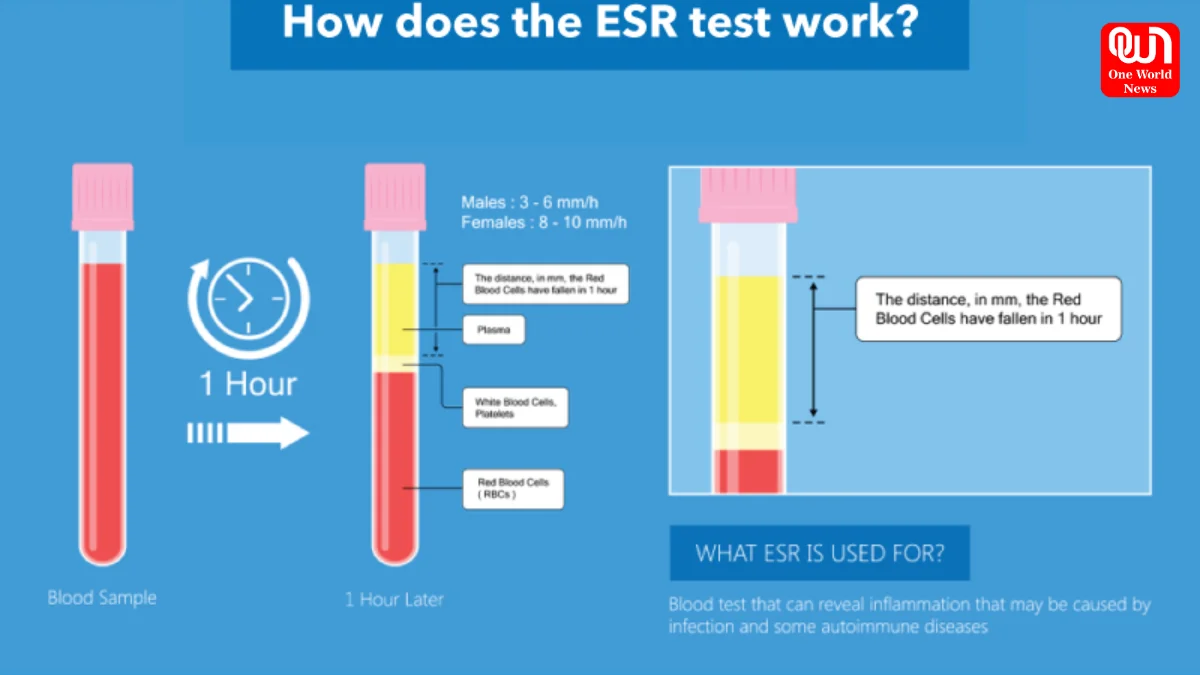ESR Test: What It Is, When It Is Advised, And How to Read Your Report
When your body faces irritation or injury, subtle changes occur in the blood. One long-used way to observe those changes is the ESR test, short for Erythrocyte Sedimentation Rate test. In many laboratories, the method is specifically listed as the Westergren ESR test. This article explains the purpose of the test, how the sample is collected, what you will typically see on the report, and the points to remember when you book ESR test online. The content below is informational. It does not confirm or assure any treatment, test, or disease on behalf of any diagnostic centre.
Basic Understanding
ESR measures how quickly red blood cells settle to the bottom of a tall, thin tube during a fixed period. The speed of settling is influenced by certain proteins that increase in the blood when there is inflammation. The result is reported as millimetres per hour. ESR is a non-specific marker. That means a higher value suggests the presence of inflammatory activity somewhere in the body, but the number alone cannot identify the exact cause.
The Westergren ESR test is the most widely adopted technique. Laboratories follow standard procedures for tube size, anticoagulant, and timing to make results comparable. Always interpret your result using the reference interval printed on your own report.
What Exactly Does the ESR Test Measure
Red blood cells normally have a slight negative charge that helps them remain suspended. During inflammation, plasma proteins change and cells form stacks called rouleaux. These stacks are heavier and settle faster. The Erythrocyte Sedimentation Rate test quantifies this settling as a single number for that sample. It is a simple physical measurement that reflects changes in the composition of plasma rather than a direct count of a particular molecule.
Why ESR Is Ordered?
A clinician may advise an ESR when symptoms or examination suggest an inflammatory process. Examples include persistent fatigue with fever, joint discomfort with morning stiffness, or long-standing symptoms that need a broad screening tool. Because ESR is non-specific, it is often used with other tests and clinical findings to build a complete picture. A normal ESR does not rule out all conditions. A raised ESR does not diagnose a specific disease. It helps with trend assessment when viewed over time.
Sample Collection and Method
The test requires a small venous blood sample. Anticoagulant is added to prevent clotting. In the Westergren method, the sample is drawn into a calibrated pipette and left upright for exactly one hour. The distance that red cells have fallen is read in millimetres and reported as mm in the first hour.
Fasting is usually not necessary for an ESR. If your visit includes other fasting tests, follow the instructions given at booking. Hydration with plain water is encouraged. The collection itself takes only a few minutes. Most centres provide results on the same day or within a business day, depending on their workflow.
Practical Tips Before You Visit
Carry a valid ID and any earlier reports. Inform the phlebotomist if you have had a recent infection, surgery, or transfusion. Mention pregnancy, current medication, or known blood disorders. These details can help your clinician interpret the number more accurately.
Reading Your ESR Report
Your report will show one main value and the reference interval used by that laboratory. Some reports display separate reference ranges by age and sex because ESR can vary with these factors. Use the comments on your own report as the primary guide. General pointers for discussion with your clinician include the following ideas.
- A result within the stated reference interval often aligns with the absence of significant systemic inflammatory activity at the time of testing.
- A mildly raised value may be seen with temporary irritation or recovery from a recent illness.
- A clearly raised result suggests active inflammation and usually prompts correlation with symptoms, examination, and other investigations.
ESR values can shift over days. A single reading is best understood in context rather than in isolation.
Understanding The Numbers Without Over-Interpreting
It is natural to compare with values read online. Resist the urge to map your report to external charts. Laboratories calibrate their own methods and create ranges that suit their equipment and population. Rely on the interval printed on your report and the explanation offered there. If a follow-up test is advised, try to use the same method so that results remain comparable.
Factors That Can Influence ESR
Several physiological and technical elements may alter the reading. Knowing these helps you discuss the result confidently.
- Age and sex can influence baseline ESR.
- Pregnancy often causes higher readings due to changes in plasma proteins.
- Anaemia can raise ESR because fewer red cells settle more readily.
- Very high white cell counts may reduce ESR.
- Temperature of the laboratory, tilt of the tube, or delays before testing can affect the measurement if the standard procedure is not followed.
- Recent transfusion or conditions that change red blood cell shape may alter results.
Because of such influences, clinicians rarely base decisions on an ESR value alone. They combine it with your history, physical examination, and other tests.
ESR and Other Inflammatory Markers
In some clinical situations, ESR is used alongside other blood markers of inflammation. Each marker behaves differently over time. ESR may change more slowly than markers that react within hours. This slower response can be helpful for watching longer trends. It also explains why a person may feel better yet still have a modestly raised ESR for a short period.
Trend Tracking Over Time
ESR is often repeated to observe direction rather than to chase a single target number. If your clinician recommends repeat testing, try to schedule follow-ups at the same centre and around the same time of day. Keep previous reports so that you can view the trajectory over weeks. When you compare, look at the date of collection, method used, and any comments on sample quality.
Booking And Price: Practical Considerations
Many people prefer to book Erythrocyte Sedimentation Rate test online or simply book ESR test online for convenience. Online booking allows you to select a time slot, confirm sample collection location, and access digital reports quickly. When you review Erythrocyte Sedimentation Rate test price or ESR test price, look at what is included.
- Is home sample collection available and is there a separate fee.
- Are both digital and printed reports provided.
- Does the report show reference intervals and method details such as “Westergren”.
Price varies by city and operational costs. Choose a centre that follows standard procedures and provides clear, well-formatted reports so that your clinician can interpret them confidently.
Common Phrases You Might See on The Report
- mm/hr indicates millimetres per hour, the standard unit.
- Westergren method confirms the technique used for measurement.
- Reference interval lists the expected range for that laboratory and may be grouped by age and sex.
- Comments may note if the sample was slightly lipaemic or if there were delays, as these can influence the number.
Read More: Signs Your Vaginal pH Balance Is Off: Symptoms Women Shouldn’t Ignore
What The ESR Test Does Not do?
The ESR does not pinpoint the location of inflammation, identify a specific infection, or provide a treatment plan. It is a simple indicator that supports clinical reasoning. A number by itself cannot be used for diagnosis. This article does not provide treatment guidance. Any personal decisions should be made with a qualified professional who has assessed you in person. Book your ESR Test with Lupin Diagnostics for accurate results, easy online booking, and reliable home sample collection.
Conclusion
The ESR test or Erythrocyte Sedimentation Rate test is a straightforward laboratory investigation that offers a broad view of inflammatory activity at the time of sampling. Using the Westergren ESR test method, laboratories report a single number in millimetres per hour, accompanied by a reference interval. Interpreted correctly, ESR helps track trends and supports clinical evaluation. It should always be considered together with your symptoms, examination findings, and other investigations.
For convenience, you can book ESR test online or book Erythrocyte Sedimentation Rate test online, receive secure digital reports, and retain previous results for comparison. When checking Erythrocyte Sedimentation Rate test price or ESR test price, review what the service includes and choose a centre that lists method details and clear ranges on the report.
Note: This informational article explains the test and how to understand the report. It does not assure or confirm any treatment, test, or disease on behalf of any diagnostics centre. It includes no offers, discounts, or comparisons with other brands. Medical interpretation must be provided by a qualified professional after a full clinical assessment.
We’re now on WhatsApp. Click to join.
Like this post?
Register at One World News to never miss out on videos, celeb interviews, and best reads.








